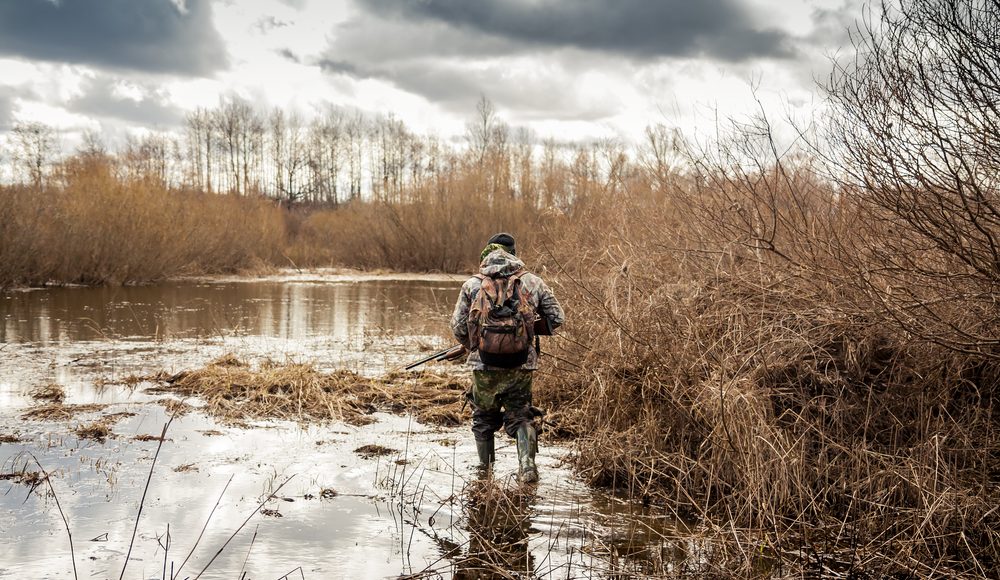Fishing, trapping, and hunting can help stretch food reserves and supplement lean harvests.
They can also prevent varmints from stealing eggs, eating crops, or killing livestock. Sometimes spontaneous opportunities to take game or varmints arise while tending to the garden or livestock or while traveling out on the trail.
While there are many ways to procure game, some of the primitive methods can be cruel and should only be attempted when the hunter has a pressing need. Otherwise, modern methods should be used, and best practices adhered to, to ensure a quick, clean kill and this article will focus on modern traps. In all cases, every part of the animal should be used, whether that animal is a wild game animal or livestock.
General Trapping & Snaring Guidance

Here are some tips to keep in mind when choosing which traps and snares to use.
Trapping, Snaring, and Fishing are Numbers Games
Ever see a survival kit with two or 4 fishhooks in it? … all the time, right? That’s all you’d need for recreational fishing, but in survival fishing, you want as many hooks in the water as possible. I carry two dozen or more hooks even in my pocket survival kit and enough lines to get them all in the water at the same time using techniques such as trotlines and bank lines.
I do this because the more baited hooks I have in the water, the more fish I’ll catch. Ask any long-line fisherman and they’ll tell you the same thing.
Traps and snare are numbers games too … the more traps or snare you have out there, the better chance you have eating the next day. Trappers talk in terms of or dozens of traps or snares and people who know to buy traps and snares by the dozen. That means that if you’re traveling on foot, weight and bulk are a big deal. We’ll talk about that some more, later.
Re-usability
Some traps are more re-usable than others, which can be a big deal in long-term survival situations where replacement parts are not available. Wire snares, for example, are easily damaged when they snare an animal that is larger than planned or when an animal fights the snare hard. The wire can become kinked and must be replaced.
Size
Traps and snares target a specific species, which determines attractants, bait, set, size, and height of traps and snares. You need to know what animal you’re after to choose an effective trap or snare.
Scent Management
When you know that the target species are in the area and your traps aren’t working, it may for several reasons. Some of the more common reasons are what the animal sees, hears, feels, tastes, or smells. Of all the senses, the sense of smell is the hardest to trick on most terrestrial species you may want to trap.
- Trap Handling – Don’t handle traps, snares, bait, or parts any more than necessary, especially not with your hands. Don’t hang around the set longer than you need to and don’t disturb the environment any more than is required to create the set.
- De-grease – If traps are heavily rusted lightly brush them with a steel brush. Boil traps and snares in with a mild degreaser such as Dawn dishwashing liquid for 5-10 minutes to remove grease. Overflow the pot after boiling to get rid of the layer of grease and oil on the surface or skim it so you don’t pull your gear back through it when you retrieve it. If you have a heated pressure washer, that’s another way to de-grease them. The point is to get all the grease and human scent off them. Boiling traps in baking soda after imparts a matte gray finish to them.
- Dye Traps – Don’t apply oil or other lubricants to traps. You want a light coat of rust on your traps before you dye them. Don’t wax body grip traps or you’ll give them a hair-trigger that could be hard on your fingers. Don’t wax traps that will be used in winter either, just dye them. Trap dye seals traps and halts the rusting process which can slow traps, prevent them from firing and shorten lifespan if allowed to progress. If you are trapping in water, apply speed dip to prevent rust stains on your pelts.
- De-scent – De-scent your hands, boots, and traps.
- Wash your hands in local surface water, scrubbing gently with sand and soil.
- Shake the water off and let everything dry naturally in the sun and wind.
- Absorb lingering scent with a rub down of black charcoal from your campfire. If you really want to go all nine yards, activate the carbon (increase its surface area) by applying a mild jet of air to it from de-scented bellows.
- Apply a masking scent obtained by crushing fragrant plants such as mint, pine needles, bayberry, yarrow, sage … you get the idea.
- Layer on some damp dirt from the area you are trapping in.
- Weather Equipment – Store your traps, chains, stakes, wire, cordage, and tools outdoors. If you store it in your house, it will smell like your house! If you transport traps in a vehicle, store them in a closed odorless plastic container.
Visibility
Under survival conditions, survivalists won’t want other people discovering their trap lines because competition for limited resources could drive others to steal equipment or food or even to set an ambush awaiting the tracker’s return. In this scenario, use tracking and counter-tracking techniques to give maintain the upper hand, choose, traps, snares, and set that are hard to notice, and camouflage them well.
Traps
The nice thing about most kinds of traps and snares is that they are out there working 24-hours a day until the trap is sprung or fouled, enabling the trapper to meet other needs until it’s time to check the trap line.
Foot Hold Traps
When most people picture a trap, they picture a foothold or leghold trap, like the bear traps they see in movies and cartoons. This type of trap has been used to trap furbearers without damaging the fur. Foothold traps are heavy but very re-useable. We have some in the family that is more than 100 years old and still in working condition. Many foothold traps can be set by stepping on the spring or springs and manipulating the jaws and trigger with a twig, eliminating the need to handle the trap with your hands. This keeps your scent off the trap and your fingers out of the business end.
Body-Grip Traps
Body grip traps are designed to make a quick kill and are sometimes called Conibear traps after the trap’s inventor, Frank Conibear. Body grip traps are highly effective (when properly set), human and reusable. They are also heavy and take up a lot of space, so you’re not going to want to carry two or three dozen in your pack, but they are my trap of choice when staying in one place.
Body-grip traps are set with a setting tool, which I strongly recommend that you use as you learn to operate these traps. The smallest body-grip traps close with enough force to break a finger if they catch you just right and the larger models can really do some damage if they close on an extremity. An injury is the last thing you need in a survival situation and care should be exercised when working with traps.
If you do decide to carry a few Conibear traps while traveling on foot, the smaller models can also be set by tying a length of paracord in a lark’s head around the spring and pulling it tight once the spring is compressed by hand. This acts as a safety to keep the trap from clamping shut while you set it but remember to not use your hands for anything you could do with a stick. This is not only for safety’s sake, but also to prevent the transfer of scent to the trap.
Rat Traps
Rat traps are light-weight and reusable, although carrying them in large numbers gets bulky. In addition to rats, rat traps work on squirrels. Rat traps are easily improved upon to make them more effective, both at catching squirrels and at catching slightly smaller and larger species.
To improve rat traps, install four screws along the edge so that the points poke up through the baseboard parallel to the bar as it lays on the base after the trap has been sprung. This modification adds holding power to the trap. If desired, a short length of wire rod can also be installed on the top of the baseboard so that it lays right next to the bar in the sprung position. This helps ensure rapid asphyxiation if the bar strike does not kill the animal outright. The last modification that should be made to rat traps is to add a sturdy eye screw to the baseboard to anchor the trap in place.
Mechanical Fisher “Fishing Yo-Yo’s”
While some survivalists whom I respect recommend them, I prefer Speedhook Snares over the Mechanical Fisher because the latter is heavier and takes up more space.
Nets
When survivalists think of nets, they most often think of gillnets. Gillnets are nets constructed of light line and designed to snare fish by their gill covers. Gillnets are hard to see underwater and when a fish runs into the net, the gill covers act as barbs, preventing the fish from exiting the net. Because gillnets are constructed of lightweight fishing lines, they are easily tangled, snagged, and broken, and maintaining one under survival conditions requires a substantial investment in both time and line. A dozen small zip-seal bags (I use MRE hot beverage bags) can serve as floats for a gillnet when filled with air and as weights when filled with rocks. Just add a little 100MPH tape near the closure, punch a hole and tie a lark’s head to fasten to the net. They weigh little and have many uses on the trail.
The type of net that I’m able to justify carrying in my pack is a general-purpose cargo/survival net. This type of net is constructed of heavier, but still light, cordage. While it isn’t as effective at catching small fish as a gillnet, it is very multiuse and can be employed to trap birds, fish, and small game, to lash bulky loads such as elk quarters to a pack frame, as camouflage netting, shade netting, the structure for a shelter and also makes for a serviceable hammock. For survivalists, it’s hard to justify carrying any piece of gear that’s a one-trick pony in your backpack, but gear that is highly adaptable makes the list.
Snares
Snares are typically much lighter weight than traps and involve either wire or cordage.
Wire Snares
Wire snares are lightweight, making it possible to set a dozen without breaking your back. Many pocket survival kits include a short length of snare wire, typically two feet or so. This only serves to give the purchaser a false sense of security.
Even you use snare wire in its intended capacity, you’ll need many yards, and remember that it often kinks when used so it won’t last long-term.
Speedhook Snares
Speedhook snares are my favorite snare for survival kits and backpacks because they’re reusable and a dozen of them weigh only a few ounces and takes up very little space (about 9” x 3” x0.5”.) If the line breaks, fishing line and hooks are all that’s typically needed to fix them.
The other parts are pieces of wire spring and fishing snap swivels so there’s not much that can’t be fixed if need be.
While they are designed to catch fish, they can also catch birds and squirrels if need be or they can be employed as a sensitive trigger in a larger trap or snare.













Bill In Idaho | January 29, 2021
|
Of All the things you mention – Residual Scent comprises the Top 10 ! Always use gloves 100% of the time – and Always use cotton gloves – Latex or Nitrile leave their own scent and it is Foreign to Animals. And for Gosh sakes, Anchor your traps Securely – Nothing worse than having a poor injured animal carrying it off.
Cache Valley Prepper | March 28, 2021
|
Great points Bill. Thanks both for reading and for your added advice!
Illini Warrior | January 29, 2021
|
in regard to using rat traps for small game …..
best to preserve that white wood base before leaving it outdoors to the climate exposure – soak it in wood preservative and then give it a multi-color enamel paint camo coat ….
a small length of carpet nail strip makes a lethal killer strip under that striker bar ( raising that striker area up only tensions it tighter) )….
you can tension up the spring by shimming up the spring end that rests against the wood base – a couple of washers will do the job nicely ….
Cache Valley Prepper | March 28, 2021
|
Thanks for reading and commenting Illini!
I was taught to use dye instead of paint, although, it probably wouldn’t matter for rodents near built areas. Thanks for sharing your modifications.
SOS Survival Products | April 14, 2022
|
I like the article, and I really appreciate it. In particular what you mentioned in your writing is General Trapping & Snaring Guidance
I’m so glad that we could talk about this topic!